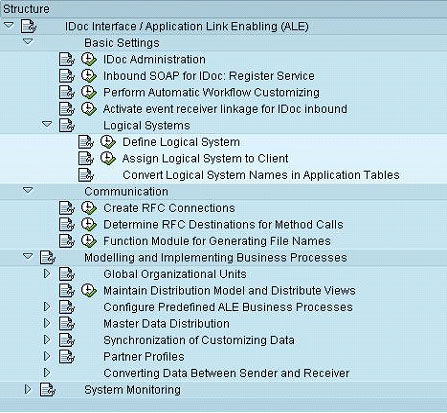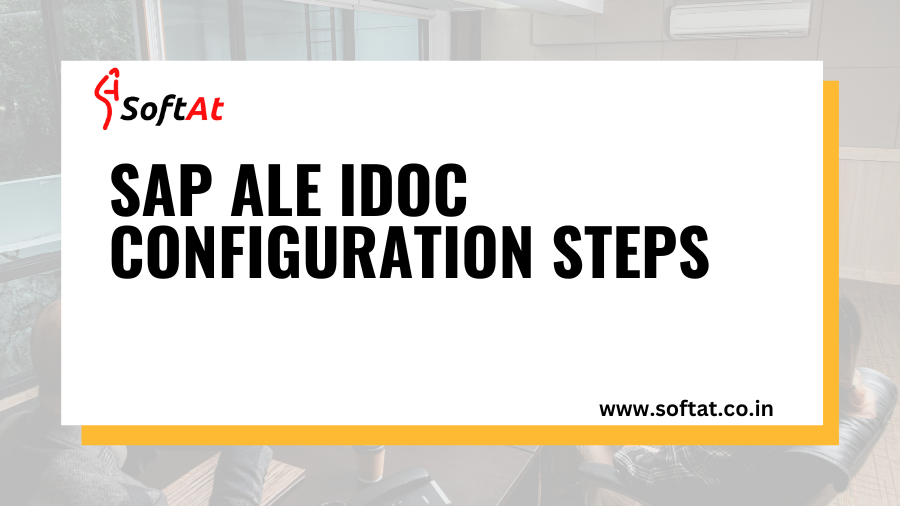In the dynamic realm of SAP, integrating disparate systems efficiently is crucial for seamless data exchange and streamlined business processes. Enter ALE (Application Link Enabling), a powerful tool facilitating communication between SAP systems and even external partners. Its cornerstone, the IDoc (Intermediate Document), acts as a standardized data container, ensuring smooth and reliable data flow. But unlocking the full potential of it requires meticulous SAP ALE IDoc configuration steps, a journey we’ll embark on in this comprehensive guide.
1. Foundational Understanding: Demystifying ALE and IDocs
- ALE: The Bridge Builder: ALE acts as a communication layer, enabling data exchange between SAP systems or external applications through standard interfaces. This fosters synchronized master data, consistent transactions, and real-time data sharing across your business landscape.
- IDoc: The Data Carrier: The IDoc serves as the vehicle for data exchange within ALE. It’s a structured container carrying data extracted from a sending system, formatted according to pre-defined message types, and delivered to the receiving system for processing.
2. Unveiling the Configuration Landscape:
- Transaction Hub: The primary configuration arena lies within transaction codes like WE20 (partner profiles), WE30 (IDoc types), and BD64 (distribution models). These transactions provide the tools to define communication channels, message formats, and data flow mappings.
- Key Configuration Steps:
- Define Logical System: Set up unique identifiers for your SAP systems within the ALE network.
- Create RFC Destinations: Establish communication channels between sending and receiving systems.
- Configure Partner Profiles: Define communication parameters for each partner system, including message types and ports.
- Design IDoc Types: Develop message structures corresponding to specific data exchange scenarios.
- Establish Distribution Models: Determine how IDocs are processed, filtered, and routed to their destinations.
3. Step-by-Step Configuration: Bringing it to Life
Scenario: Consider a scenario where you want to send customer master data from one SAP system to another using ALE IDocs. Let’s walk through the key configuration steps:
- Logical Systems: Create logical systems representing both sending and receiving systems (e.g., DEV and PRD).
- RFC Destinations: Configure RFC destinations defining communication channels between the systems.
- Partner Profiles: Establish partner profiles for each system, specifying message types (e.g., DEBMAS for customer data) and ports for data exchange.
- IDoc Types: Create an IDoc type (e.g., DEBMAS01) mirroring the customer master data structure, including segments, fields, and data types.
- Distribution Models: Define a distribution model to control IDoc processing. Specify the sending and receiving systems, filter criteria (e.g., specific customers), and message triggers (e.g., customer creation).
Remember, this is a simplified example. The actual configuration steps may vary depending on your specific data exchange scenario and system setup.
4. Advanced Configuration Gems: Unveiling Deeper Functionality
- Change Pointers: Leverage change pointers to trigger IDoc creation automatically whenever relevant data changes, ensuring real-time synchronization.
- Outbound Processing Modes: Choose between different outbound processing modes, such as synchronous or asynchronous, based on your transaction requirements and performance needs.
- Inbound Processing: Configure inbound processing steps, including error handling, status updates, and data mapping to integrate received IDocs seamlessly into your target system.
5. Optimizing Your Configuration: Best Practices and Tips
- Documentation is Key: Document your configuration thoroughly, including partner profiles, IDoc types, and distribution models. This facilitates future maintenance and troubleshooting.
- Testing is Crucial: Test your IDoc configuration rigorously in a development environment before deploying it to production, ensuring data integrity and smooth communication.
- Security Matters: Implement appropriate security measures, such as user authorization and data encryption, to protect sensitive data during transmission.
- Stay Updated: Keep pace with evolving SAP releases and best practices by attending trainings, consulting documentation, and engaging with the SAP community.
6. Beyond the Basics: Exploring Additional Configuration Options
- Customizing IDoc Types: Extend standard IDoc types with additional segments and fields to cater to specific data exchange needs.
- Outbound Processing Enhancements: Utilize user exits and filters to manipulate outbound IDocs before transmission, adding extra data or tailoring them to specific requirements.
- Inbound Processing Integrations: Integrate inbound IDoc processing with custom ABAP programs or workflows, triggering specific actions based on received data.
By mastering SAP ALE IDoc configuration steps, you unlock a powerful tool for streamlined data exchange, promoting greater integration, efficient processes, and real-time visibility across your SAP landscape.
1. Conquering Advanced Scenarios:
Multi-System Landscapes: Master the complexity of data exchange in multi-system environments with cascading IDoc processing, involving multiple sending and receiving systems. Leverage message splitting and consolidation techniques for efficient data flow management.
EDI Integration: Connect your SAP system with external partners using standardized Electronic Data Interchange (EDI) formats like EDIFACT or XML. Understand message mapping, conversion techniques, and security considerations for seamless EDI integration.
Real-Time Data Replication: Implement real-time data replication scenarios using techniques like ALE Remote Function Calls (RFCs) or Advanced Business Application Programming (ABAP) to ensure immediate data synchronization across systems.

2. Troubleshooting Like a Pro:
Error Handling and Analysis: Become an expert in analyzing error messages associated with IDoc processing. Utilize transaction WE02 to view IDoc details, identify errors, and apply appropriate solutions.
Debugging and Trace Analysis: Delve deeper into debugging techniques using transaction ST22 and trace analysis tools to pinpoint the root cause of complex IDoc processing issues.
Performance Optimization: Analyze IDoc processing performance with tools like ST05 and address bottlenecks by optimizing distribution models, filters, and processing logic.
3. Continuous Improvement: Optimizing Your Configuration
Monitoring and Auditing: Regularly monitor IDoc processing activity using transactions like BD87 and BD97 to identify trends, analyze data volumes, and track performance metrics.
Security Reviews and Updates: Conduct periodic security reviews of your ALE configuration to ensure adherence to best practices and address potential vulnerabilities. Keep your system updated with the latest security patches and SAP releases.
User Training and Knowledge Sharing: Empower your team with comprehensive training on SAP ALE IDoc configuration steps concepts, troubleshooting techniques, and best practices. Foster a culture of knowledge sharing and continuous learning within your organization.
4. Beyond the Guide: Resources and Community Support
SAP Help Portal: Leverage the wealth of information available in the official SAP Help Portal, offering detailed documentation, configuration guides, and troubleshooting tips.
SAP Community Forums: Engage with the vibrant SAP community on forums and discussion boards to seek help, share knowledge, and learn from the experiences of other ALE users.
Specialized Consulting: Consider seeking expert advice from specialized SAP ALE consultants for complex scenarios, performance optimization, or system integrations.
Remember, the world of SAP ALE IDoc configuration is an ever-evolving landscape. Embrace continuous learning, stay updated with the latest advancements, and actively engage with the community to ensure your SAP ALE IDoc configuration steps remains robust, efficient, and a valuable asset for your organization’s data exchange needs.
As you embark on this journey, keep in mind the following key takeaways:
- Embrace a methodical approach: Follow a structured configuration process, document your steps meticulously, and test thoroughly before deployment.
- Understand your specific needs: Tailor your configuration to your unique data exchange scenarios and business requirements.
- Leverage advanced features: Explore advanced configuration options and tools to extend functionality and streamline communication.
- Monitor and optimize: Continuously monitor performance, address issues promptly, and adapt your configuration to evolving needs.
- Seek help and share knowledge: Don’t hesitate to seek support from the SAP community or specialized consultants, and contribute your own expertise to help others.
By mastering the art of SAP ALE IDoc configuration steps, you unlock a powerful tool for seamless data exchange, ensuring a well-integrated, efficient, and data-driven SAP landscape that empowers your organization for success.
Browse More About Trending Blogs @
https://www.softat.co.in/edi-integration-with-sap-idoc/
https://www.softat.co.in/difference-between-edi-and-ale/
https://www.softat.co.in/sap-edi-electronic-data-interchange/
https://www.softat.co.in/sap-idoc/





